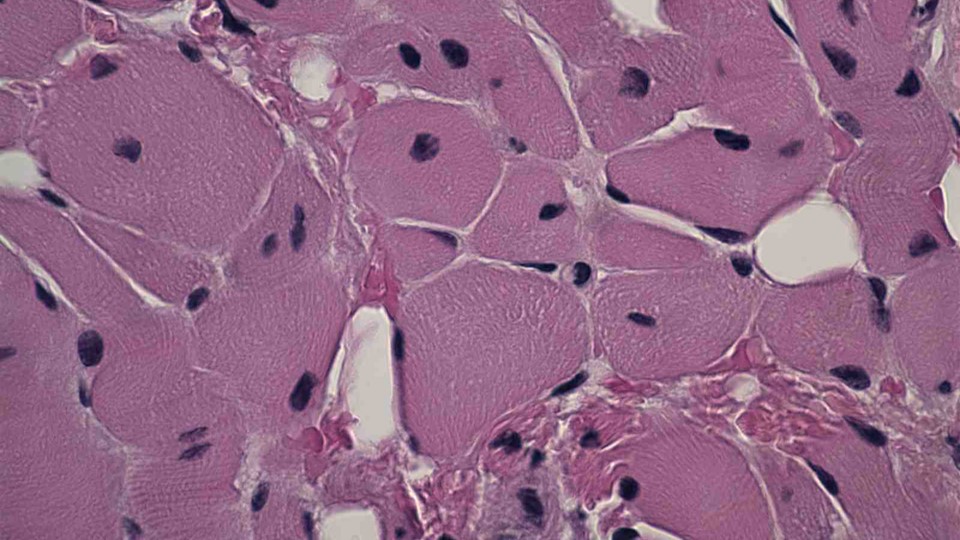Myotubular and centronuclear myopathies represent a heterogenous group of muscular conditions that is associated with muscle weakness, skeletal problems, abnormal gait and fatigability among other medical conditions. The clinical findings associated with these myopathies, varies in severity from individual to individual (Amburgey et al. 2017; Fujimura-Kiyono, Racz, and Nishino 2008). For instance, myotubular myopathy can be present in its life-threatening, neonatal form, as well as its less severe intermediate form, or it can appear later in life in its slowly progressive form (Cassandrini et al. 2017). Our laboratory is interested in studying DNA and muscle samples of these patients since it would provide insight into the genetic cause of their muscular condition which would also inform on the prognostic of the disease.
Changes in DNM2, BIN1, TTN, and MTM1 genes have been found to be most often associated with centronuclear myopathy (Amburgey et al. 2017; Tasfaout, Cowling, and Laporte 2018). TThese genes are important for incorporating substances into the muscle cells, along with helping maintain the structure, and the function of the muscle cells (Tasfaout, Cowling, and Laporte 2018). Very rarely cases of centronuclear myopathies have also been associated with RYR1 and MTMR14 (Jungbluth, Wallgren-Pettersson, and Laporte 2008).
Further understanding of these genes could have direct clinical benefit to patients and their families by allowing for specific diagnostic testing such as carrier detection and prenatal diagnosis for those who wish. In addition, understanding the genetic cause(s) of Centronuclear and Myotubular myopathy will increase our understanding of muscle biology and provide insights into future development of specific treatments and therapies.

Muscles cells exhibiting classic Centronuclear Myopathy with an increased number of nuclei (dark spots) located in the middle of the cells as opposed to being on the edge of the cell (which is the case in normal muscle cells).
Genetics
The exact inheritance of Centronuclear and Myotubular myopathy may be either autosomal dominant, autosomal recessive, or X-linked depending on which gene is affected (Fujimura-Kiyono, Racz, and Nishino 2008). The autosomal dominant form, found in cases with mutations in the DNM2 gene, is usually associated with slow progression of muscle weakness (Tasfaout, Cowling, and Laporte 2018; Catteruccia et al. 2013). Changes in the TTN and BIN1 genes are usually inherited in an autosomal recessive fashion (Jungbluth and Gautel 2014). Although their onset is not neonatal, it usually is earlier than that of the autosomal dominant form. In addition, the degree of severity of this form is often intermediate. The X-linked form of Myotubular Myopathy is associated with mutations in the MTM1 gene, and is usually associated with neonatal onset and severe presentation (Tasfaout, Cowling, and Laporte 2018).
Research
Since there are patients with myotubular myopathy with no detectable gene change, it is the purpose of our study to determine what other genes may be involved in myotubular myopathy, how they can arise and how they are inherited. Our group of scientists and clinicians is trying to understand the changes that occur in the muscle of patients with myotubular myopathy, with the hope that this will lead to improved treatment for this condition. In order to carry out our research, we need the help of families. If you are the parent of a child with myotubular myopathy, if you yourself are affected, or if you are a healthcare provider of a patient with myotubular myopathy, you may be able to help us develop better therapies and treatments for this disorder.
References
Amburgey, K., E. Tsuchiya, S. de Chastonay, M. Glueck, R. Alverez, C. T. Nguyen, A. Rutkowski, J. Hornyak, A. H. Beggs, and J. J. Dowling. 2017. 'A natural history study of X-linked myotubular myopathy', Neurology 89: 1355-64.
Cassandrini, D., R. Trovato, A. Rubegni, S. Lenzi, C. Fiorillo, J. Baldacci, C. Minetti, G. Astrea, C. Bruno, and F. M. Santorelli. 2017. 'Congenital myopathies: clinical phenotypes and new diagnostic tools', Ital J Pediatr 43: 101.
Catteruccia, M., F. Fattori, V. Codemo, L. Ruggiero, L. Maggi, G. Tasca, C. Fiorillo, M. Pane, A. Berardinelli, M. Verardo, C. Bragato, M. Mora, L. Morandi, C. Bruno, L. Santoro, E. Pegoraro, E. Mercuri, E. Bertini, and A. D'Amico. 2013. 'Centronuclear myopathy related to dynamin 2 mutations: clinical, morphological, muscle imaging and genetic features of an Italian cohort', Neuromuscul Disord. 23: 229-38.
Fujimura-Kiyono, C., G. Z. Racz, and I. Nishino. 2008. 'Myotubular/centronuclear myopathy and central core disease', Neurol India 56: 325-32.
Jungbluth, H., and M. Gautel. 2014. 'Pathogenic mechanisms in centronuclear myopathies', Front Aging Neurosci. 6: 339.
Jungbluth, H., C. Wallgren-Pettersson, and J. Laporte. 2008. 'Centronuclear (myotubular) myopathy', Orphanet J Rare Dis. 3: 26.
Tasfaout, H., B. S. Cowling, and J. Laporte. 2018. 'Centronuclear myopathies under attack: A plethora of therapeutic targets', J Neuromuscul Dis. 5: 387-406.
This page was last updated October 23, 2020.